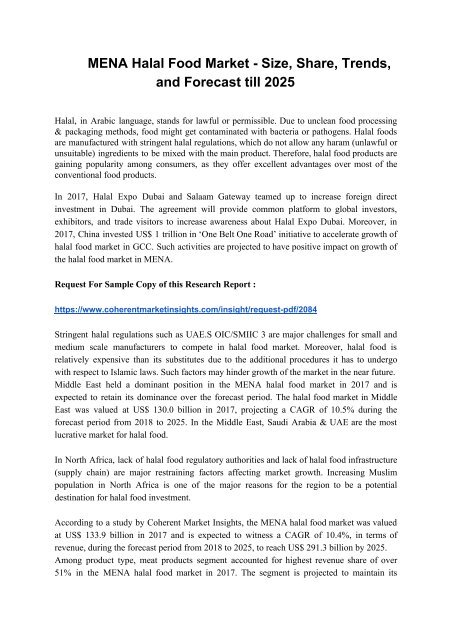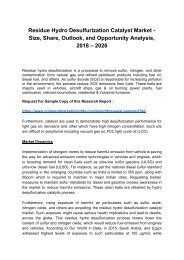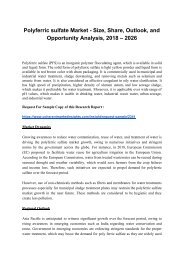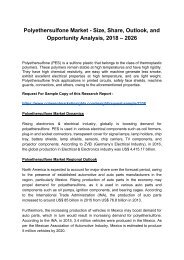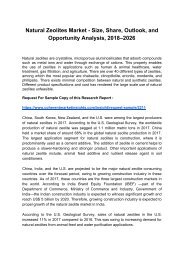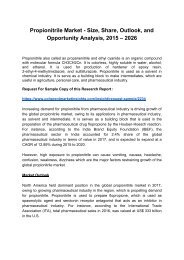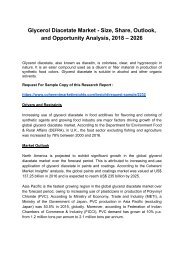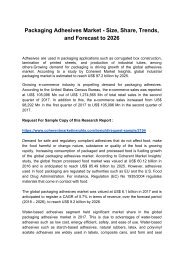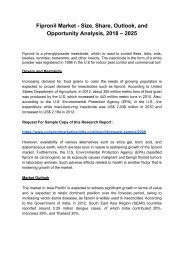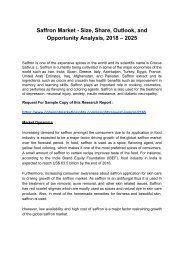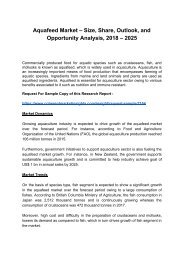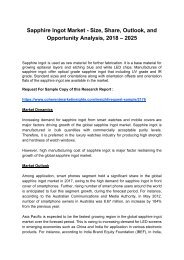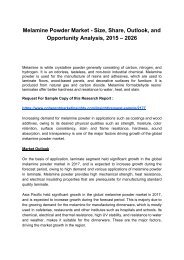MENA Halal
The Middle East and North Africa (MENA) Halal Food Market research report segments the report by Product Type, Distribution Channel, and by Region (Middle East and North Africa) - Size, Share, Trends, and Forecast till 2025
The Middle East and North Africa (MENA) Halal Food Market research report segments the report by Product Type, Distribution Channel, and by Region (Middle East and North Africa) - Size, Share, Trends, and Forecast till 2025
Create successful ePaper yourself
Turn your PDF publications into a flip-book with our unique Google optimized e-Paper software.
<strong>MENA</strong> <strong>Halal</strong> Food Market - Size, Share, Trends,<br />
and Forecast till 2025<br />
<strong>Halal</strong>, in Arabic language, stands for lawful or permissible. Due to unclean food processing<br />
& packaging methods, food might get contaminated with bacteria or pathogens. <strong>Halal</strong> foods<br />
are manufactured with stringent halal regulations, which do not allow any haram (unlawful or<br />
unsuitable) ingredients to be mixed with the main product. Therefore, halal food products are<br />
gaining popularity among consumers, as they offer excellent advantages over most of the<br />
conventional food products.<br />
In 2017, <strong>Halal</strong> Expo Dubai and Salaam Gateway teamed up to increase foreign direct<br />
investment in Dubai. The agreement will provide common platform to global investors,<br />
exhibitors, and trade visitors to increase awareness about <strong>Halal</strong> Expo Dubai. Moreover, in<br />
2017, China invested US$ 1 trillion in ‘One Belt One Road’ initiative to accelerate growth of<br />
halal food market in GCC. Such activities are projected to have positive impact on growth of<br />
the halal food market in <strong>MENA</strong>.<br />
Request For Sample Copy of this Research Report :<br />
https://www.coherentmarketinsights.com/insight/request-pdf/2084<br />
Stringent halal regulations such as UAE.S OIC/SMIIC 3 are major challenges for small and<br />
medium scale manufacturers to compete in halal food market. Moreover, halal food is<br />
relatively expensive than its substitutes due to the additional procedures it has to undergo<br />
with respect to Islamic laws. Such factors may hinder growth of the market in the near future.<br />
Middle East held a dominant position in the <strong>MENA</strong> halal food market in 2017 and is<br />
expected to retain its dominance over the forecast period. The halal food market in Middle<br />
East was valued at US$ 130.0 billion in 2017, projecting a CAGR of 10.5% during the<br />
forecast period from 2018 to 2025. In the Middle East, Saudi Arabia & UAE are the most<br />
lucrative market for halal food.<br />
In North Africa, lack of halal food regulatory authorities and lack of halal food infrastructure<br />
(supply chain) are major restraining factors affecting market growth. Increasing Muslim<br />
population in North Africa is one of the major reasons for the region to be a potential<br />
destination for halal food investment.<br />
According to a study by Coherent Market Insights, the <strong>MENA</strong> halal food market was valued<br />
at US$ 133.9 billion in 2017 and is expected to witness a CAGR of 10.4%, in terms of<br />
revenue, during the forecast period from 2018 to 2025, to reach US$ 291.3 billion by 2025.<br />
Among product type, meat products segment accounted for highest revenue share of over<br />
51% in the <strong>MENA</strong> halal food market in 2017. The segment is projected to maintain its
dominance over the forecast period, owing to increasing consumption of meat products in<br />
<strong>MENA</strong> region. According to the study conducted by Agriculture & Agri-Food Canada on<br />
livestock and meat trends in the Gulf Cooperation Council (GCC), imports of meat & meat<br />
products was valued at US$ 5 billion in 2015.<br />
Among distribution channel, supermarkets segment accounted for largest revenue share of<br />
45% in <strong>MENA</strong> halal food market in 2017. The segment is projected to maintain its<br />
dominance throughout the forecast period, owing to growing presence of supermarket chains.<br />
For instance, according to the United States Department of Agriculture (USDA) 2017 Report,<br />
the total number of supermarkets in Egypt were 1,056 in 2016 and it is increased to over<br />
1,215 in 2016. Moreover, promotional and marketing activities in the form of offering<br />
lucrative discounts on products, wide variety of products to choose from, and fair presence of<br />
private label products are some of the key factors attributing to the rapid growth of this<br />
segment.<br />
Major Players in the <strong>MENA</strong> <strong>Halal</strong> Food Market -<br />
Some of the major players operating in the <strong>MENA</strong> halal food market include Cargill Inc., Al<br />
Islami Foods, BRF, Agthia, Fine Foods, Rhodes Food Group Holdings Ltd, Global Food<br />
Industries, LLC, and Alpha Fine Foods.<br />
For More Information:<br />
https://www.coherentmarketinsights.com/market-insight/mena-halal-food-market-2084<br />
About Coherent Market Insights:<br />
Coherent Market Insights is a prominent market research and consulting firm offering<br />
action-ready syndicated research reports, custom market analysis, consulting services, and<br />
competitive analysis through various recommendations related to emerging market trends,<br />
technologies, and potential absolute dollar opportunity.<br />
Contact Us:<br />
Mr. Shah<br />
Coherent Market Insights<br />
1001 4th Ave,<br />
#3200<br />
Seattle, WA 98154<br />
Tel: +1-206-701-6702<br />
Email: sales@coherentmarketinsights.com


